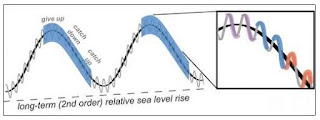Rapid tectonic and climate changes can
markedly influence lake extent and character, with distinct expression along-
and across-strike. Ghinassi et al.
suggest that although the morphological along-strike variability of lacustrine
coasts is relatively well understood, the nature and signature of this
variability on the sedimentological and stratigraphic record of lacustrine
systems is poorly documented. This study documents how lacustrine water-level
oscillations are recorded in different depositional systems along strike in
late Holocene shoreline deposits of Lake Hayk of Ethiopia. The results
illustrate low-relief margins with fluvial-deltaic systems and high-relief
margins with collvial fan deltas and stromatolitic biostromes. The data reveal
possible pitfalls of classical stratigraphic approaches used to establish
along-strike correlation between lacustrine sedimentary successions, important
for paleoenvironmental studies, subsurface exploration and stratigraphic
investigations.
Over Phanerozoic time scales, sedimentary records from the
continental interior, or craton, tend to be thinner and less stratigraphically
complete than coeval deposits from the continental margin, where subsidence
allows marine basins to accumulate thick sedimentary records. Here, Brady tests
whether the relationship between subsidence and stratigraphic completeness
holds true at the finer temporal scales during which facies and cycles
accumulate. The results of a quantitative comparison of Devonian carbonate
records from the craton and continental margin suggest that, over this ~5 m.y.
time period, the thin cratonic record is a result of low sedimentation rates
and submarine omission, rather than minimal subsidence and increased potential
for subaerial exposure. This study demonstrates how a quantitative approach can
lead to new insights into important (non-)depositional processes and towards
improved sampling strategies when comparing sedimentary records from distinct
basins.
Distinguishing
allogenic and autogenic processes on the distribution and patterns of channel
belts of fluvial systems is challenging because both can control avulsions
across a range of time scales and because of incomplete preservation. In
this paper, Flood and Hampson present a quantitative analysis of the distribution of channelized fluvial
sandbodies within the widely studied Blackhawk Formation of the Wasatch
Plateau, central Utah. The results indicate that: 1) spatial patterns of
sandbody distribution can be attributed to avulsion of deltaic distributary
channels in locations downstream of long-lived avulsion nodes in the lower part
of the Blackhawk Formation, or by compensational stacking of sandbodies in the
upper part of the Blackhawk Formation, and 2) tectonic subsidence rate varied
markedly during deposition (c. 80-700 m/Myr), but any potential variation in
its relationship to avulsion frequency had little influence on avulsion style.
This study demonstrates the importance of collecting large outcrop datasets,
which enable quantitative characterization of sandbody distributions and
related stratigraphic architectures using spatial statistical methods.


